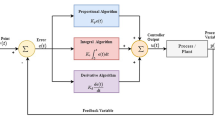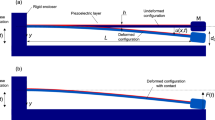Abstract
Piezoelectric actuators generally exhibit nonlinear hysteresis characteristics. The compensation of hysteresis is mandatory for improving the tracking control accuracy of the piezoelectric actuator system. This paper proposes a robust RST digital feedback controller in order to compensate hysteresis nonlinearity and subsequently to improve the tracking control accuracy of the piezoelectric actuator system. To design the proposed controller, first the dynamics of the considered piezoelectric actuator system is identified experimentally. Then, a controller is designed based on pole placement with sensitivity functions shaping methodology and applied to piezoelectric actuator system. The performance of the proposed controller is compared with a general approach of using inverse Prandtl-Ishlinskii hysteresis model as a feed-forward controller. The achieved experimental results with proposed RST digital feedback controller show improved performances with respect to those obtained with inverse Prandtl-Ishlinskii hysteresis model in overall suppressing the hysteresis nonlinearity by 96.5% and reducing the peak-to-peak tracking error by 93.6%. The peak to peak tracking error of less than 2% for the desired displacement of 18 \(\upmu\)m with tracking frequency of 10 Hz is also achieved. These experimental results validate the effectiveness of the proposed control scheme.











Similar content being viewed by others
References
Ahmad I, Voda A, Besançon G, Buche G (2012) Robust digital control approach for high performance tunneling current measurement system. Control Eng Pract 20(7):643–653
Al Janaideh M, Naldi R, Marconi L, Krejci P (2012) A hybrid system for a class of hysteresis nonlinearity: modeling and compensation. In: IEEE 51st annual conference on decision and control (CDC). IEEE, pp 5380–5385
Janaideh Al, Rakotondrabe M, Aljanaideh O (2015) Further results on hysteresis compensation of smart micropositioning systems with the inverse prandtl-ishlinskii compensator. IEEE Trans Control Syst Technol 24(2):428–439
Bhikkaji B, Ratnam M, Fleming AJ, Moheimani SR (2007) High-performance control of piezoelectric tube scanners. IEEE Trans Control Syst Technol 15(5):853–866
Binnig G, Rohrer H (2000) Scanning tunneling microscopy. IBM J Res Dev 44(1/2):279
Boettcher U, Callafon RAD, Talke FE (2010) Modeling and control of a dual stage actuator hard disk drive. J Adv Mech Des Syst Manuf 4(1):107–118
Chen X, Wen S, Wang D, Su CY (2015) Adaptive control for micro/nano positioning system driven by piezo electric actuator. In: IEEE 24th international symposium on industrial electronics (ISIE), pp 66–71
Chuang N, Petersen IR, Pota HR (2013) Robust hinfinity control in fast atomic force microscopy. Asian J Control 15(3):872–887
Devasia S, Eleftheriou E, Moheimani SR (2007) A survey of control issues in nanopositioning. IEEE Trans Control Syst Technol 15(5):802–823
Fleming AJ (2011) A method for reducing piezoelectric non-linearity in scanning probe microscope images. In: American control conference (ACC). IEEE, pp 2861–2866
Gan J, Zhang X, Wu H (2016) A generalized prandtl-ishlinskii model for characterizing the rate-independent and rate-dependent hysteresis of piezoelectric actuators. Rev Sci Instrum 87(3):035,002
Huber J, Fleck N, Ashby M (1997) The selection of mechanical actuators based on performance indices. Proc R Soc Lond A Math Phys Eng Sci 453:2185–2205
Ismail M, Ikhouane F, Rodellar J (2009) The hysteresis bouc-wen model, a survey. Arch Comput Methods Eng 16(2):161–188
Janaideh MA, Mao J, Rakheja S, Xie W, Su CY (2008) Generalized prandtl-ishlinskii hysteresis model: hysteresis modeling and its inverse for compensation in smart actuators. In: 47th IEEE conference on decision and control. IEEE, pp 5182–5187
Landau I (1998) The RST digital controller design and applications. Control Eng Pract 6(2):155–165
Landau ID, Karimi A (1998) Robust digital control using pole placement with sensitivity function shaping method. Int J Robust Nonlinear Control 8(LA-ARTICLE-2007-036):191–210
Langer J, Landau I (1997) Combined pole placement/sensitivity function shaping method using convex optimization criteria. In: European control conference (ECC). IEEE, pp 2484–2489
Liu Y, Liu H, Wu H, Zou D (2015) Modelling and compensation of hysteresis in piezoelectric actuators based on maxwell approach. Electron Lett 52(3):188–190
Liu Y, Zhou M (2015) Kp model for hysteresis of piezoelectric ceramic actuators. In: Chinese automation congress (CAC). IEEE, pp 253–257
Mayergoyz I (2012) Mathematical models of hysteresis. Springer-Verlag
Muschielok A, Andrecka J, Jawhari A, Brückner F, Cramer P, Michaelis J (2008) A nano-positioning system for macromolecular structural analysis. Nat Methods 5(11):965–971
Ouyang R, Jayawardhana B (2014) Absolute stability analysis of linear systems with duhem hysteresis operator. Automatica 50(7):1860–1866
Pantazi A, Sebastian A, Antonakopoulos T, Bächtold P, Bonaccio AR, Bonan J, Cherubini G, Despont M, DiPietro RA, Drechsler U, et al (2008) Probe-based ultrahigh-density storage technology. IBM J Res Dev 52(4.5):493–511
Pare TE, How JP (1998) Robust stability and performance analysis of systems with hysteresis nonlinearities. In: Proceedings of the American control conference, vol. 3. IEEE, pp 1904–1908
Riccardi L, Naso D, Turchiano B, Janocha H (2014) Design of linear feedback controllers for dynamic systems with hysteresis. IEEE Trans Control Syst Technol 22(4):1268–1280
Salapaka SM, Salapaka MV (2008) Scanning probe microscopy. IEEE Control Syst 28(2):65–83
Smith RC (2005) Smart material systems: model development, vol. 32. Siam
Xiao S, Li Y (2013) Modeling and high dynamic compensating the rate-dependent hysteresis of piezoelectric actuators via a novel modified inverse preisach model. IEEE Trans Control Syst Technol 21(5):1549–1557
Zhang W, Pang M, Ru C (2016) Nanopositioning for lithography and data storage. In: Nanopositioning technologies. Springer, New York, pp 381–409
Zirka SE, Moroz YI, Harrison RG, Chwastek K (2012) On physical aspects of the jiles-atherton hysteresis models. J Appl Phys 112(4):043,916
Acknowledgements
The author would like to extend their sincere appreciation to the Deanship of Scientific Research (DSR) at King Saud University for its funding of this research through the Research Group Project No. RGP-1436-012.
Author information
Authors and Affiliations
Corresponding author
Additional information
The original version of this article was revised: "Unfortunately, the eighth sentence of the Abstract contains an error".
An erratum to this article is available at http://dx.doi.org/10.1007/s00542-016-3228-1.
Rights and permissions
About this article
Cite this article
Ahmad, I., Abdurraqeeb, A.M. Tracking control of a piezoelectric actuator with hysteresis compensation using RST digital controller. Microsyst Technol 23, 2307–2317 (2017). https://doi.org/10.1007/s00542-016-3213-8
Received:
Accepted:
Published:
Issue Date:
DOI: https://doi.org/10.1007/s00542-016-3213-8




